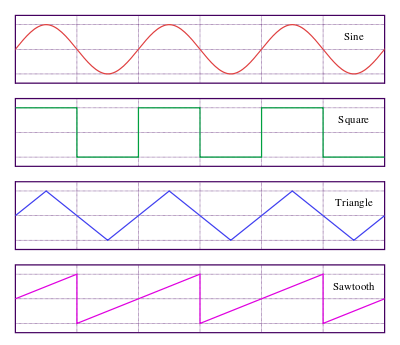Waveform
A waveform is the shape and form of a signal such as a wave moving in a physical medium or an abstract representation.
In many cases the medium in which the wave propagates does not permit a direct observation of the true form. In these cases, the term "waveform" refers to the shape of a graph of the varying quantity against time. An instrument called an oscilloscope can be used to pictorially represent a wave as a repeating image on a screen.
To be more specific, a waveform is depicted by a graph that shows the changes in a recorded signal's amplitude over the duration of recording.[1] The amplitude of the signal is measured on the -axis (vertical), and time on the -axis (horizontal).[1]
Examples of waveforms
Most programs show waveforms to give the user a visual aid of what has been recorded. If the waveform is of low or high height (with respect to the axis), the recording was most likely conducted under conditions with a low or high input volume, respectively. From this example, it follows that the curve represented by the waveform is affected by both the input signal and conditions under which it is recorded.[1]
A periodic waveforms include these while is time, is wavelength, is amplitude and is phase:
- Sine wave. The amplitude of the waveform follows a trigonometric sine function with respect to time.
- Square wave. This waveform is commonly used to represent digital information. A square wave of constant period contains odd harmonics that decrease at −6 dB/octave.
- Triangle wave. It contains odd harmonics that decrease at −12 dB/octave.
- Sawtooth wave. This looks like the teeth of a saw. Found often in time bases for display scanning. It is used as the starting point for subtractive synthesis, as a sawtooth wave of constant period contains odd and even harmonics that decrease at −6 dB/octave.
Other waveforms are often called composite waveforms and can often be described as a combination of a number of sinusoidal waves or other basis functions added together.
The Fourier series describes the decomposition of periodic waveforms, such that any periodic waveform can be formed by the sum of a (possibly infinite) set of fundamental and harmonic components. Finite-energy non-periodic waveforms can be analyzed into sinusoids by the Fourier transform.
See also
- AC waveform
- Arbitrary waveform generator
- Spectrum analyzer
- Waveform monitor
- Waveform viewer
- Wave packet
References
- Yuchuan Wei, Qishan Zhang. Common Waveform Analysis: A New And Practical Generalization of Fourier Analysis. Springer US, Aug 31, 2000
- Waveform Definition
- 1 2 3 "Waveform Definition". techterms.com. Retrieved 2015-12-09.
Further reading
- Hao He, Jian Li, and Petre Stoica. Waveform design for active sensing systems: a computational approach. Cambridge University Press, 2012.
- Solomon W. Golomb, and Guang Gong. Signal design for good correlation: for wireless communication, cryptography, and radar. Cambridge University Press, 2005.
- Jayant, Nuggehally S and Noll, Peter. Digital coding of waveforms: principles and applications to speech and video. Englewood Cliffs, NJ, 1984.
- M. Soltanalian. Signal Design for Active Sensing and Communications. Uppsala Dissertations from the Faculty of Science and Technology (printed by Elanders Sverige AB), 2014.
- Nadav Levanon, and Eli Mozeson. Radar signals. Wiley. com, 2004.
- Jian Li, and Petre Stoica, eds. Robust adaptive beamforming. New Jersey: John Wiley, 2006.
- Fulvio Gini, Antonio De Maio, and Lee Patton, eds. Waveform design and diversity for advanced radar systems. Institution of engineering and technology, 2012.
- John J. Benedetto, Ioannis Konstantinidis, and Muralidhar Rangaswamy. "Phase-coded waveforms and their design." IEEE Signal Processing Magazine, 26.1 (2009): 22-31.
External links
| Wikimedia Commons has media related to Waveforms. |
- Collection of single cycle waveforms sampled from various sources
